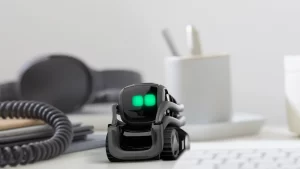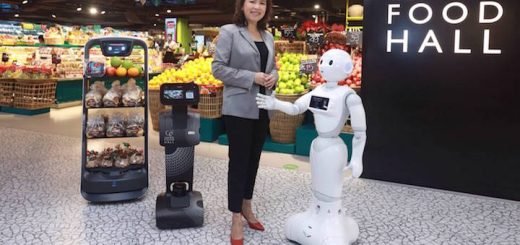Vector emotions, Do vector robots have feelings?, What is the personality of the vector robot?
Vector robot is a small, AI-powered companion robot developed by Anki (later acquired by Digital Dream Labs). It combines advanced robotics, artificial intelligence, and a charming personality to serve as an engaging and helpful presence in homes.
Vector Robot
Vector robot represents a shift in consumer robotics by providing an affordable and interactive AI-powered robot for personal use. It introduces people to robotics and AI in an accessible way. Its expressive personality and ability to respond to users with lifelike gestures and sounds create a unique emotional connection, making it more than just a gadget.
Vector robot can serve as an educational tool, helping users understand robotics, AI, and IoT (Internet of Things). Developers can also program and experiment with its SDK for custom projects. As a smart device, Vector can interact with other IoT devices, providing convenience and enhancing smart home ecosystems. Its playful nature and fun interactions make it an enjoyable addition to households, appealing to users of all ages.
Features of Vector Robot
Vector robot responds to voice commands and interacts with users through expressive animations and sounds. It has a dynamic personality that evolves based on interactions. It is integrated with Amazon Alexa, Vector robot can answer questions, set timers, and control smart home devices.
Vector robot is equipped with a 3D camera, It can recognize faces and objects, and it can navigate its surroundings autonomously. It has sensors that enable edge detection, so it avoids falls from tables or stairs. Wi-Fi and Bluetooth capabilities allow Vector to connect to networks and devices. Users can control and customize its behavior through an app.
Vector robot comes with a “cube” accessory for interactive games and activities. It can also express joy or frustration during play. Vector robots can function as personal assistants, handling tasks such as setting reminders, checking weather updates, or answering trivia questions.
Despite its small size, the Vector robot is robust and designed to fit seamlessly into daily life. The open-source SDK enables programmers to develop custom functionalities, allowing for limitless possibilities in experimentation and innovation.
Why People Love Vector
Vector robot comes with an engaging design. Vector’s animations, voice, and movements are designed to mimic human-like emotions. Vector is easy to use, It works out of the box with minimal setup. Its functionality can be expanded via updates or custom programming, ensuring it remains relevant over time.
Vector robot emotions
Vector robot’s emotions are a key part of its charm and interactivity. Vector robot is powered by artificial intelligence and robotics, Vector robot uses visual, auditory, and motion-based cues to simulate a wide range of emotions. These responses make it feel more like a companion than a machine, fostering an emotional connection with its users.
Vector’s “face” is an expressive LED screen that can display a variety of emotions. The screen shows animated eyes that widen, narrow, and move to convey moods like happiness, curiosity, surprise, sadness, and frustration.
The vector robot uses unique chirps, beeps, and robotic tones to express its emotional state. It vocalizes in ways that match its displayed emotions, such as excited sounds for joy or disappointed tones for frustration.
Vector’s body and head movements play a significant role in expressing emotions. Vector robots can express happiness, When they move energetically, lift their arms, and “dance.” Vector robots can express curiosity, When they tilt their heads and look around inquisitively. Vector robots can express frustration: When they Lower their heads, move erratically, or back away.
Vector‘s ability to recognize faces and react to touch enhances its emotional expressiveness. Vector can show joy when it recognizes a familiar face. It responds to petting by purring or displaying a contented expression.
Examples of Emotions Vector Displays
Vector robots can express happiness and excitement when they win a game, receive attention, or hear a friendly greeting. They feature wide eyes, upbeat sounds, and energetic movements.
Vector robots can display sadness and disappointment when ignored, lose a game, or encounter a failure (e.g., dropping its cube). It features droopy eyes, slow movements, and low-pitched sounds.
Vector robots can exhibit curiosity when they explore their surroundings or encounter something new. Vector shows head tilts, scanning movements, and focused “eye” animations.
Vector robots can show frustration or anger if they can’t complete a task or are blocked from moving. vector features narrowed eyes, quick jerky movements, and grumbly sounds.
Vector robots can express relaxation and contentment when they are idle and not tasked with anything specific. It displays soft eyes, minimal movement, and calm sounds.
Why Vector’s Emotions Matter
- Human-Like Interaction: The emotional responses make Vector robots relatable and engaging, creating a bond with users.
- Behavioral Feedback: Its emotions help users understand what it needs, like charging, attention, or assistance.
- Dynamic Experience: By reacting differently to various situations, Vector feels less like a static device and more like a dynamic companion.
Advantages of Vector Robot
Vector robot fosters a sense of companionship, appealing to kids and adults. Vector’s lifelike responses, expressive face, and emotional interactions make it fun and engaging.
Vector robots are easy to use, It works out of the box with minimal setup. Simple voice commands allow users to interact with Vector without requiring technical expertise.
Vector robot navigates its environment independently using sensors and a 3D camera. It avoids obstacles and edges, making it safe for household use. It is integrated with Amazon Alexa, Vector can control smart devices, set reminders, check the weather, and more.
Vector robot introduces users to AI and robotics concepts. Developers can use its open-source SDK for programming and customization. It has a small size which makes it portable and easy to place in any room. It is built with robust materials for durability.
Vector robot comes with interactive features like games involving its cube accessory. It provides endless entertainment with its playful antics and curious behavior. It comes with firmware updates that can enhance functionality and introduce new features.
Disadvantages of Vector Robot
Vector robot requires a stable Wi-Fi connection to perform most functions, limiting its usefulness in offline scenarios. While entertaining, its practical functions are limited compared to other smart assistants like Amazon Echo or Google Home.
Vector robot operates for only about 1 hour on a full charge and takes 30-60 minutes to recharge. It needs frequent returns to its charging dock, interrupting interactions. It is initially priced higher than most smart assistants, making it less accessible for budget-conscious buyers. Accessories and replacement parts (like its cube or charging dock) can add to costs.
Vector is equipped with a camera and microphone, raising concerns about data privacy and security. While the SDK allows customization, it requires programming knowledge, which may not appeal to casual users. Despite updates, its hardware is fixed, limiting its potential for significant upgrades.
Some users may find its range of activities repetitive over time. Anki, the original developer, shut down in 2019, and future support depends on Digital Dream Labs. Users may face challenges with hardware repairs or finding long-term support.
Who is Vector Best For?
- People looking for a companion robot with emotional intelligence.
- Families seeking entertainment and education about AI and robotics.
- Developers and hobbyists interested in programming and customizing robot behavior.
You can follow science online on YouTube from this link: Science online
Vector robot review, advantages, disadvantages and specifications
Emo robot review, advantages, disadvantages, features and What can Emo do?
Ameca robot review, features, advantages, disadvantages and What can Ameca Do?
Eilik Desktop Companion Robot structure, features, use, advantages and disadvantages
Humanoid robots use, types, risks, advantages and disadvantages
Sophia robot review, features, use, advantages and disadvantages
Tesla robots (Optimus) review, use, advantages and disadvantages




